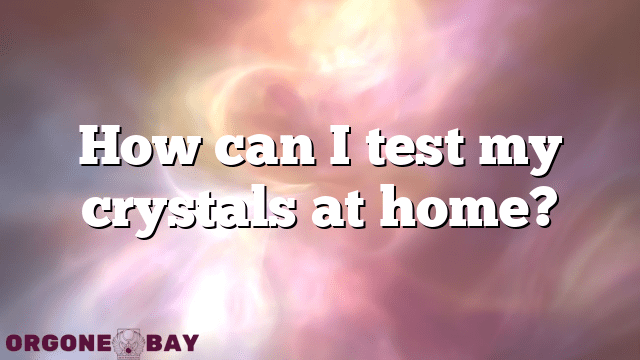Crystal Care & Maintenance
How can I test my crystals at home?
If you’re wondering how to test your crystals at home, one method is to perform the streak test. This technique involves using a white or black unglazed porcelain tile to crush the crystal and observe the resulting color. Here are some steps to follow for conducting a streak test:
• First, choose a small, unimportant area of the crystal to test.
• Next, rub the crystal against the porcelain tile in a back-and-forth motion, applying gentle pressure.
• Observe the color of the resulting streak on the tile. This will give you an idea of the crystal’s true color and composition.
• Some crystals will leave a distinctive streak while others may not produce any visible color on the tile.
• It’s important to note that this test is not foolproof and should not be relied upon as the only means of identifying a crystal. However, it can be a helpful tool when used in conjunction with other methods of crystal testing.
Other methods of testing crystals at home include examining their physical properties like hardness, luster, and cleavage, as well as using a magnifying glass or microscope to inspect their surface details. Remember, proper identification of a crystal is important for choosing the right healing properties and using it effectively in your spiritual practice.
Table Of Contents
- 1 Importance of testing crystals at home
- 2 Performing the streak test
- 3 Difference between white and black unglazed porcelain tiles
- 4 How to prepare porcelain tiles for testing
- 5 Types of crystals that can be tested using the streak method
- 6 Analyzing the results
- 7 Other methods for testing crystals at home
Importance of testing crystals at home
Testing crystals before using them is important to ensure that they are authentic and of good quality. Testing also helps to determine the properties of a crystal, which can be helpful in choosing the right one for specific purposes. Conducting tests at home is a convenient way to determine these properties without the need for expensive equipment or specialist assistance. One method for testing crystals at home is the streak test.
Performing the streak test
The streak test is a simple and effective method for testing the color properties of a crystal. All you need to perform this test are unglazed porcelain tiles and the crystal you wish to test. Place the crystal on the porcelain tile and drag it across the surface. Depending on the type of crystal and its properties, it will leave a distinctive streak of color on the tile.
Difference between white and black unglazed porcelain tiles
Both white and black unglazed porcelain tiles can be used for the streak test, but they have different properties that can affect your results. White tiles are often used for lighter colored crystals, whereas black tiles are better for darker colored crystals. This is because the color of the porcelain can affect the way the crystal’s color appears on the tile.
How to prepare porcelain tiles for testing
Before conducting the streak test, it is important to prepare the porcelain tiles properly. First, clean the tiles with soap and water and dry them with a soft cloth. Then, scratch the surface of the tile with the crystal you are testing to ensure that it is unglazed. If the crystal does not leave a mark, the tile is glazed and cannot be used for the streak test.
Types of crystals that can be tested using the streak method
Many crystals can be tested using the streak method, including minerals such as hematite and pyrite. Hematite leaves a reddish-brown streak, whereas pyrite leaves a greenish-black streak. Other crystals, such as quartz and amethyst, may not leave a visible streak on the tile but can be identified by their color.
Analyzing the results
The color of the streak left by the crystal on the porcelain tile can provide insights into its properties. Some crystals may leave a streak that is different from the color of the crystal itself, which indicates that it contains impurities. By analyzing the color and properties of the crystal, you can learn more about its potential uses and properties.
Other methods for testing crystals at home
In addition to the streak test, there are other methods for testing crystals at home, including the hardness test and the light test. The hardness test involves scratching the crystal against a known substance, whereas the light test involves shining a light through the crystal to determine its clarity. When combined with the streak test, these methods can provide a more comprehensive analysis of a crystal’s properties.

